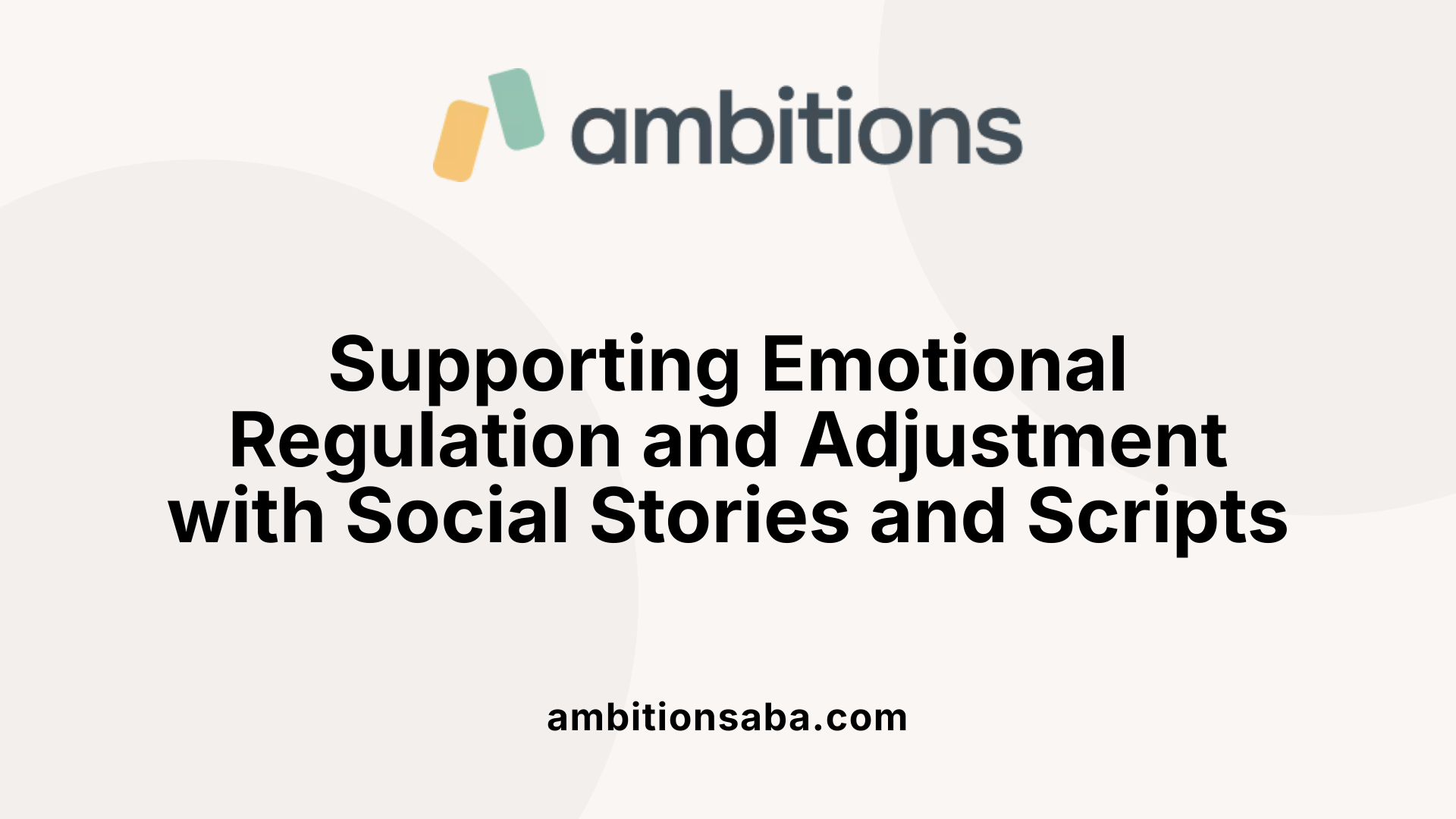Understanding the Power of Social Scripts and Stories
Adapting to new or unfamiliar situations can be challenging, especially for children with developmental delays or autism. Social scripts and stories serve as essential tools that help individuals understand and navigate social interactions by providing clear, personalized guidance. These interventions facilitate emotional and social development, fostering confidence and independence.
What Are Social Scripts and Stories?

What are social scripts and social stories, and how do they support social skills and emotional development?
Social scripts and social stories are educational tools used to introduce and explain social situations, expectations, and appropriate responses. These tools typically combine simple narratives, visuals, and structured language to make social concepts accessible.
Social stories are short, personalized stories that describe specific social situations from the child's perspective. They include details about what will happen, how others might feel, and what the child can do to respond appropriately. For example, a social story about visiting the doctor might outline the steps of the visit, what the child can expect to see, and how to handle feelings of nervousness.
Similarly, social scripts are often structured as visual aids or written conversations that teach specific social skills, like greeting someone or asking for help. They break down behaviors into manageable steps, providing scripts that children can emulate.
These tools support social skills development by helping children understand social cues, routines, and the expectations of various interactions. They are especially helpful for children with developmental delays, autism spectrum disorder, or social-emotional challenges. By reducing confusion and anxiety, social stories and scripts promote confidence and enhance emotional regulation.
Proactively using these resources before new experiences or transitions prepares children, easing fears and fostering smoother social participation. They also help children recognize their feelings, understand others' perspectives, and develop appropriate responses.
Overall, social stories and scripts are vital in making complex social concepts understandable, promoting emotional growth, and building social competence in young learners. Their customization allows tailoring to individual needs, making them effective tools in early childhood education and therapy.
Benefits and Components of Using Social Scripts

What are the key benefits of using social scripts and stories in social skills development?
Using social scripts and stories offers numerous advantages for individuals working on social and emotional skills, particularly those with autism spectrum disorder (ASD). These tools serve as clear, accessible guides that help children and young adults understand social norms, expected behaviors, and typical reactions in various situations.
One major benefit is their ability to reduce social anxiety and problematic behaviors. By providing a predictable framework and visual cues, social stories reassure children, making unfamiliar or stressful scenarios more manageable. This sense of familiarity helps decrease anxiety and behavioral outbursts.
Social scripts also promote social engagement and communication. They can teach children how to initiate conversations, take turns, and respond appropriately, boosting confidence and independence.
Furthermore, these interventions support emotional regulation by helping children identify and understand their feelings through visual aids like emotion charts or masks.
Social stories and scripts are versatile, aiding in learning specific skills such as asking permission, following routines, and navigating new environments. When integrated with other strategies like play, role-playing, and visual supports, they create a comprehensive approach to fostering social competence.
What components do social stories and scripts include?
Social stories and scripts are structured around certain sentence types that serve different purposes:
| Component Type | Description | Purpose |
|---|---|---|
| Descriptive Sentences | Define what happens in the social situation | Clarify the context and sequence of events |
| Perspective Sentences | Provide insight into how others feel or think | Promote empathy and understanding |
| Directive Sentences | Guide what the child should do in the situation | Encourage appropriate responses |
| Affirmative Sentences | Reinforce positive behaviors and outcomes | Build confidence and motivation |
| Control Sentences | Set limits or rules to prevent problematic behaviors | Establish boundaries and expectations |
| Cooperative Sentences | Foster cooperation and positive interactions | Support social harmony and teamwork |
These components are tailored to the child's needs and often incorporate visuals and positive language to make the social story engaging and effective.
How are social scripts integrated with other therapeutic methods?
Social scripts and stories are most effective when used alongside other interventions such as speech therapy, occupational therapy, and behavioral techniques like the Turtle Technique or visual cue systems. They serve as practical tools within a broader, positive programming plan aimed at enhancing social understanding, reducing anxiety, and encouraging positive behaviors.
Regular review, reinforcement, and role-play are essential to solidify learning. By combining scripts with multimedia tools like videos or interactive activities, educators and therapists can create engaging learning experiences that accommodate individual learning styles.
Overall, social stories and scripts act as personalized, mini-guides that support social-emotional development across different environments—school, home, and community—making social learning more structured, predictable, and achievable.
Creating and Using Social Stories for New Situations

How can social scripts and stories be created and used to support individuals in adjusting to new or challenging situations?
Developing effective social stories and scripts begins with identifying the specific situation or behavior that requires support. For example, a child preparing for a visit to the dentist or starting a new school can benefit from a tailored story that describes what to expect and how to behave.
The next step involves breaking down the situation into manageable steps or key components. This often includes observing the individual’s reactions and understanding their specific needs or challenges.
Creating the story then entails writing personalized narratives that include visual supports—such as pictures, drawings, or symbols—that align with the story’s content. These visual cues help with comprehension and make the story more engaging.
The stories should be written in simple, positive language from the child's point of view. Incorporating different sentence types enhances understanding:
| Sentence Types | Purpose | Example |
|---|---|---|
| Descriptive | Explain what happens | "First, I put on my coat." |
| Perspective | Share feelings and thoughts | "I may feel nervous, but that’s okay." |
| Directive | Guide expected behavior | "Next, I ask for help if I’m unsure." |
| Affirmative | Reinforce positive behavior | "I can do this!" |
Professionals such as speech-language pathologists or psychologists can customize these stories further to suit the individual’s language level and behavioral goals. Their expertise ensures the stories are developmentally appropriate and effective.
Once created, the stories should be reviewed regularly. Repeating the story before the event or situation helps build familiarity and reduce anxiety. Role-playing and rehearsals can reinforce understanding and help the individual practice appropriate responses.
Incorporating visual supports, such as emotion masks or picture cues, alongside the story can enhance comprehension.
Overall, the combination of personalized storytelling, visual aids, and consistent practice makes social stories a valuable tool for helping individuals navigate new or challenging situations with confidence.
Supporting Adjustment and Emotional Regulation in Special Needs Populations

How do social stories and scripts help children and individuals with special needs in adjusting to changes?
Social stories and scripts are valuable tools that assist children with special needs in adapting to new situations and routines. They provide clear, simple explanations of what to expect, which helps to reduce feelings of anxiety and uncertainty. These stories often use visual aids like pictures or drawings, making abstract ideas more concrete and understandable for children with cognitive or language impairments.
By breaking down complex situations into manageable steps and highlighting expected behaviors, social stories teach children how to respond appropriately. They foster confidence by giving children a reliable mental framework of upcoming changes, whether it’s a move to a new house, visiting the doctor, or starting a new school year.
Moreover, social stories promote emotional understanding and social skills. They model empathy by helping children see different perspectives and understand how others might feel in certain situations. This perspective-taking encourages compassionate responses and enhances emotional regulation.
The use of these stories not only prepares children mentally but also builds self-regulation skills, teaching them to manage their emotions during transitions. Their repetitive reading and visual reinforcement make this learning process engaging and effective. Overall, social stories and scripts create a sense of predictability, increase a child's sense of security, and support smoother, less stressful adjustments to changes in their environment.
Best Practices and Guidelines for Using Social Stories
What are some best practices or guidelines for using social stories to prepare children for unfamiliar or challenging situations?
Creating effective social stories involves several important steps to ensure they are impactful and tailored to each child's needs. First, stories should be simple, concise, and highly personalized. This means focusing on the specific situation the child will face and using language they understand. Visual supports, such as pictures or icons, are crucial as they help children better grasp the content and increase engagement.
The language used in social stories should be positive and descriptive. For instance, instead of emphasizing what not to do, focus on what the child can do, using words like "first," "next," and "last" to sequence events clearly. Including details about what to expect, how they might feel, and appropriate responses reduces uncertainty and anxiety.
Timing and repetition are essential components. Reading the social story multiple times—starting one to two weeks before the event—helps reinforce understanding. Repetition through reading and role-playing prepares children for real-world application, making the coping strategies more familiar.
Involving children in the creation or selection of their social stories can increase their engagement and ownership over the learning process. When children contribute ideas or choose their stories, they become more motivated to learn and apply the social rules.
Monitoring the child's reactions and the story's effectiveness is also important. Adjustments can be made based on their responses, and stories can be revisited as needed to support skill generalization across different environments.
In summary, personalized, visual-rich, positively worded stories read regularly and actively involving the child in their development create a solid foundation for supporting children through new or difficult experiences. Healthcare and educational professionals often recommend these strategies, emphasizing that social stories are most effective when integrated into a comprehensive support plan.
Fostering Growth Through Visual and Narrative Supports
Incorporating social scripts and stories into a child's development equips them with vital skills to navigate social complexities confidently. These tools, when personalized and applied consistently, can significantly reduce anxieties associated with new or challenging situations, foster emotional understanding, and promote social competence. Collaboration among parents, educators, and professionals ensures that social stories are effectively tailored and integrated into daily routines, making social learning an engaging and achievable goal for children with diverse needs. As a result, children learn not only to manage specific situations but also build a foundation of self-awareness and resilience, essential for lifelong social and emotional growth.
References
- Using Social Stories to Improve Your Child's Understanding ...
- Using Social Stories to Prepare for Changes - Watson Institute
- Using Social Scripts to Support New Social Situations - Kerry's Place
- Behavioral Issues and the Use of Social Stories: Articles
- Free library of Social Stories for Autism | Autism Behavior Services, Inc.
- Resources: Practical Strategies for Teachers/Caregivers
- Prepare For New Situations With Social Stories - Empirian Therapy
- Social Stories (TM) - KSDE TASN



